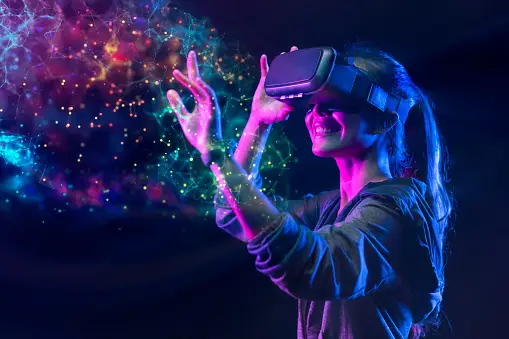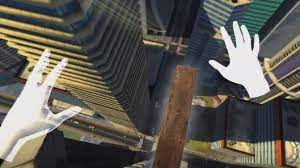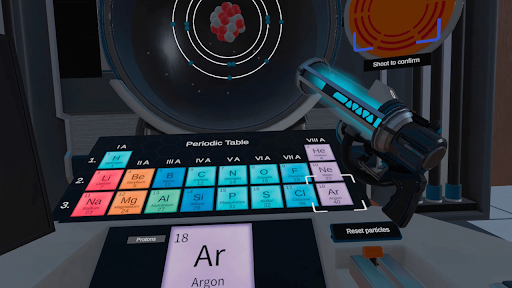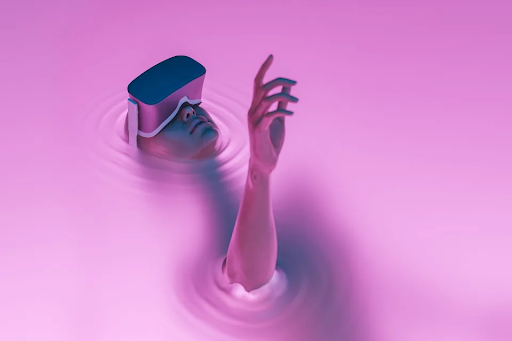
Imagine you step out onto the wooden plank 100 stories above the pavement. Feel the thrill and the drop of your stomach as the board creaks while you step forward. That unsettling feeling is exactly how I felt while playing “Richie’s Plank Experience,” a virtual reality game where you enter an elevator and exit on a wooden plank incredibly high up from the ground. This unique ability to create such a realistic feeling is through virtual reality. These virtual reality experiences have revolutionized the way we interact with technology. This advanced technology blurs the line between the physical and virtual worlds. As we dive deeper into these immersive environments, one question arises: do immersive extended reality experiences create new kinds of uncertainty that are valuable, problematic, or some combination of the two? While virtual reality can positively influence education, these experiences also cause problems like worry, lack of productivity, and safety issues through uncertainty.
Immersive reality creates a lot of uncertainty. This uncertainty provokes curiosity and exploration due to the vast unknown. By stepping into virtual reality and navigating unique realities, users come across unfamiliar situations and unpredictable elements such as terrain, obstacles, and individuals. This uncertainty serves as a stepping stone for discovery. It can make users push boundaries and discover new possibilities within the immersive reality environment. Throughout virtual reality games such as Richie’s Plank Experience and Beat Saber, users are tested in their ability to face adversity and obstacles all while having fun. This is incredibly fascinating how technology has the potential to create such a realistic reality simply through a headset.

All of these things reign true throughout my personal experience with immersive technology in Studio X here at the University of Rochester and from my experience at home. It has the power to blur the lines between reality, which I personally find unsettling. For example, while in Studio X, I decided to try “Richie’s Plank Experience,” a virtual reality game where you enter an elevator and exit on a plank extremely high up. When these elevator doors opened, I immediately became uncomfortable and my stomach fell to the floor. What’s crazy is that I knew I was standing on the ground; however, I was so consumed in this headset it felt so authentic like I was really walking on a plank above a city. Additionally, I tested out the virtual reality roller caster which I had to take a seat for. I found it so captivating that this headset was able to create the same feeling as if I was on a real rollercoaster, stomach-churning and all. As a user, I found it very unsettling that a silly little headset had the ability to make my stomach drop to the ground as if I were actually riding a rollercoaster or on a plank above a city.
This advanced technology can also be used to catapult our understanding of education and make it fun. Boring topics can be made fun and entertaining through the use of virtual reality. Similarly, concepts that people may have trouble grasping by reading texts can come to life in virtual environments. Students can become more interested in the material and start to learn by completing virtual experiments relating to the material. For example, virtual reality lessons on reaction balancing from Futuclass, an app designed to make teaching subjects such as Chemistry, Physics, Biology, Music, and History more engaging, and is being used around the world to assist students in their learning journey. It can help students understand chemical reactions in a way that a textbook cannot. Additionally, Futuclass is a prime example of presenting education in a way to makes students more engaged and comprehend the content better. Apps like this are a great example of the benefits of virtual reality in today’s society.

However, there is a layer of complexity that can also be noted. The uncertainty present in virtual reality experiences can cause feelings of anxiety and discomfort for some users. As the user experiences an unfamiliar environment, they may feel overwhelmed by the lack of control they have or just how real it appears. I can personally relate to this through my experiences with virtual reality as well. This aspect of uncertainty poses a significant challenge and can be problematic. It can hinder users' ability to fully engage with virtual reality technology and potentially prevent them from exploring their full potential. Instead of really immersing into the headset, users can potentially be hesitant to engage and enjoy the benefits of this device. Throughout a Yahoo Finance article, it is discovered through a study that “one week working in the metaverse led to 19% more anxiety and 16% less productivity.” So while there are positives that arise when using virtual reality, the downsides must also be noted. I can relate to the anxiety felt by employees in this workplace and understand how it can negatively influence the workplace. The environment of a workplace is crucial to its success. These noticeable declines in the workplace occurred only after one week of working with Metaverse, so what could that look like after three months? These limitations of virtual reality are important to recognize and take into consideration when determining its impact on society.
Additionally, uncertainty in immersive reality raises safety concerns that should not be ignored. In virtual reality environments, users may encounter situations that blur the lines between reality and simulation, creating a problematic environment. The lack of clear boundaries and consequences within virtual reality experiences can pose serious risks to user’s physical and psychological well-being. Users can immediately feel dizziness, nausea, or eye strain after using the headset. A few individuals who have worn VR headsets extensively every day have reported lasting eye damage due to the technology. Although there is limited research on the long-term effects of XR use. These issues demand designers of these headsets to carefully consider the safety measures and guidelines in design and usage.

So while the potential of this new technology is incredibly fascinating, the downsides can not be ignored either. Hindering productivity and possibly causing anxiety, virtual reality can have negative impacts if used incorrectly or too much. Despite these challenges and unsettling nature, uncertainty in virtual reality also offers valuable opportunities for learning and fun. Users get to navigate uncertain territory and confront obstacles. It has the possibility to transform educational environments for the better. Through this experience, users can develop critical thinking skills and face adversity, all while having fun at the same time. This advancement in education can be the variable that catapults education upward. Ultimately, it can inspire users to experience different environments and learn in unique ways both within and beyond the environment of virtual reality.
Works Cited
7 Benefits of Virtual Reality (Explained!). Dec. 2022, https://futuclass.com/blog/benefits-of-virtual-reality/.
Bove, Tristan. One Week Working in the Metaverse Led to 19% More Anxiety and 16% Less Productivity, New Study Finds. June 2022, https://finance.yahoo.com/news/one-week-working-metaverse-led-164453743.html.


